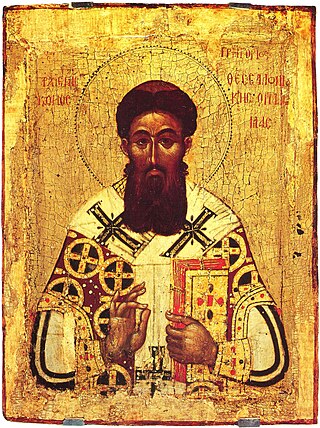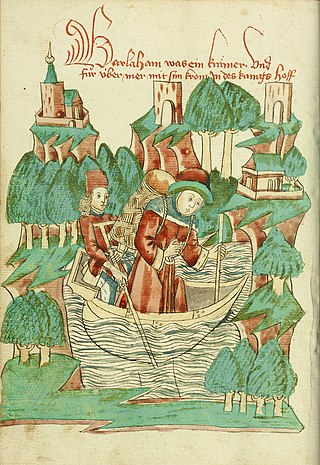Related Research Articles

Andronikos II Palaiologos, Latinized as Andronicus II Palaeologus, reigned as Byzantine emperor from 1282 to 1328. His reign marked the beginning of the recently restored empire's final decline. The Turks conquered most of Byzantium's remaining Anatolian territories, and Andronikos spent the last years of his reign fighting his own grandson in the First Palaiologan Civil War. The war ended in Andronikos' forced abdication in 1328, after which he retired to a monastery for the remainder of his life.

Gregory Palamas was a Byzantine Greek theologian and Eastern Orthodox cleric of the late Byzantine period. A monk of Mount Athos and later archbishop of Thessalonica, he is famous for his defense of hesychast spirituality, the uncreated character of the light of the Transfiguration, and the distinction between God's essence and energies. His teaching unfolded over the course of three major controversies, (1) with the Italo-Greek Barlaam between 1336 and 1341, (2) with the monk Gregory Akindynos between 1341 and 1347, and (3) with the philosopher Gregoras, from 1348 to 1355. His theological contributions are sometimes referred to as Palamism, and his followers as Palamites.

Germanus I was the Patriarch of Constantinople from 715 to 730. He is regarded as a saint by both the Orthodox and Roman Catholic Churches, with a feast day of 12 May. He had been ecumenically preceded by Patriarch John VI of Constantinople, and was succeeded in Orthodox Rite by Patriarch Constantine II of Constantinople.

Barlaam of Seminara, c. 1290–1348, or Barlaam of Calabria was a Basilian monk, theologian and humanistic scholar born in southern Italy. He was a scholar and clergyman of the 14th century, as well as a humanist, philologist and theologian.
The East–West Schism, also known as the Great Schism or the Schism of 1054, is the break of communion between the Catholic Church and the Eastern Orthodox Church since 1054. A series of ecclesiastical differences and theological disputes between the Greek East and Latin West preceded the formal split that occurred in 1054. Prominent among these were the procession of the Holy Spirit (Filioque), whether leavened or unleavened bread should be used in the Eucharist, iconoclasm, the coronation of Charlemagne as Emperor of the Romans in 800, the Pope's claim to universal jurisdiction, and the place of the See of Constantinople in relation to the pentarchy.

"Servant of the servants of God" is one of the titles of the Pope and is used at the beginning of papal bulls.

John IV, also known as John Nesteutes, was the 33rd bishop or Patriarch of Constantinople. He was the first to assume the title Ecumenical Patriarch. He is regarded as a saint by the Eastern Orthodox Church which holds a feast on September 2.

Fifth Council of Constantinople is a name given to a series of seven councils held in the Byzantine capital Constantinople between 1341 and 1368, to deal with a dispute concerning the mystical doctrine of Hesychasm. These are referred to also as the Hesychast councils or the Palamite councils, since they discussed the theology of Gregory Palamas, whom Barlaam of Seminara opposed in the first of the series, and others in the succeeding six councils.
Gregory of Cyprus was Ecumenical Patriarch of Constantinople between 1283 and 1289.

Methodios I or Methodius I was Ecumenical Patriarch of Constantinople from March 4, 843 to June 14, 847. He was born in Syracuse and died in Constantinople. His feast day is celebrated on June 14 in both the East and the West.

John XI Bekkos was Patriarch of Constantinople from June 2, 1275, to December 26, 1282, and the chief Greek advocate, in Byzantine times, of the reunion of the Eastern Orthodox and Roman Catholic Churches.
Athanasius I was the Ecumenical Patriarch of Constantinople for two terms, from 1289 to 1293 and 1303 to 1309. He was born in Adrianople and died in Constantinople. Chosen by the emperor Andronicus II Palaeologus as patriarch, he opposed the reunion of the Greek and Roman Churches and introduced an ecclesiastic reform that evoked opposition within the clergy. He resigned in 1293 and was restored in 1303 with popular support. The pro-Union clerical faction forced him into retirement in early 1310.
The Metropolis of Derkoi is a residential see of the Eastern Orthodox Church subject to the Ecumenical Patriarch of Constantinople and situated in the Istanbul suburb of Yesilköy. The cathedral is that of St. Parakevi in Therapia (Tarabya). The metropolitan is a member of the Patriarchal Synod. The present Metropolitan is Apostolos Daniilidis.
Athanasius III served as Greek Patriarch of Alexandria between 1276 and 1308.

The Hesychast controversy was a theological dispute in the Byzantine Empire during the 14th century between supporters and opponents of Gregory Palamas. While not a primary driver of the Byzantine Civil War of 1341, it influenced and was influenced by the political forces in play during that war. The dispute concluded with the victory of the Palamists and the inclusion of Palamite doctrine as part of the dogma of the Eastern Orthodox Church as well as the canonization of Palamas.
Constantine Meliteniotes was a Greek ecclesiastical writer in the Byzantine Empire and a prominent supporter of the Union of Lyons between the Greek Orthodox Church and the Roman Catholic Church. He is best known as one of the two archdeacons of Patriarch John XI Bekkos who, together with him, were imprisoned and exiled in the years following the breakdown of the union; he remained under house arrest until his death.
Christianity is an Abrahamic monotheistic religion based on the life and teachings of Jesus as interpreted in the Bible. It is the largest religion in the world, with 2.4 billion people, known as Christians, that adhere to the religion.
This is a timeline of the presence of Eastern Orthodoxy in Greece from 1204 to 1453. The history of Greece traditionally encompasses the study of the Greek people, the areas they ruled historically, as well as the territory now composing the modern state of Greece.
George Moschabar was a thirteenth-century Greek Orthodox theologian, who was active in Constantinople during the decades of the 1270s and 1280s, at times serving there as professor of scriptural exegesis. He wrote against the Union of Lyons, at first anonymously, then, when the union was abrogated under Emperor Andronikos II, he took an active part in the synods that enforced a restoration of Orthodoxy. Under Patriarch Gregory II of Constantinople, Moschabar served as chartophylax, i.e., patriarchal secretary, but, because of disagreements between him and the patriarch, he stepped down from that office and worked to bring about Gregory's resignation.
The schism between the Ecumenical Patriarchate of Constantinople and the Russian Orthodox Church occurred between approximately 1467 and 1560. This schism de facto ended supposedly around 1560.